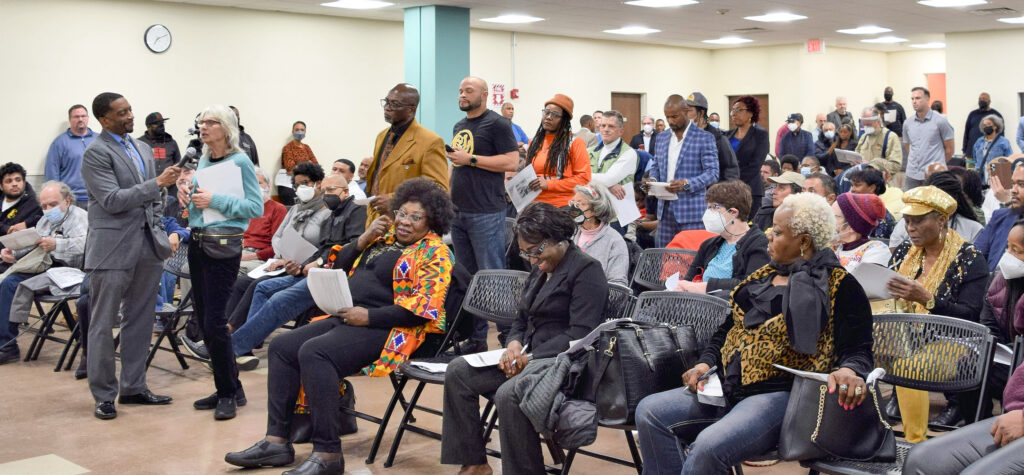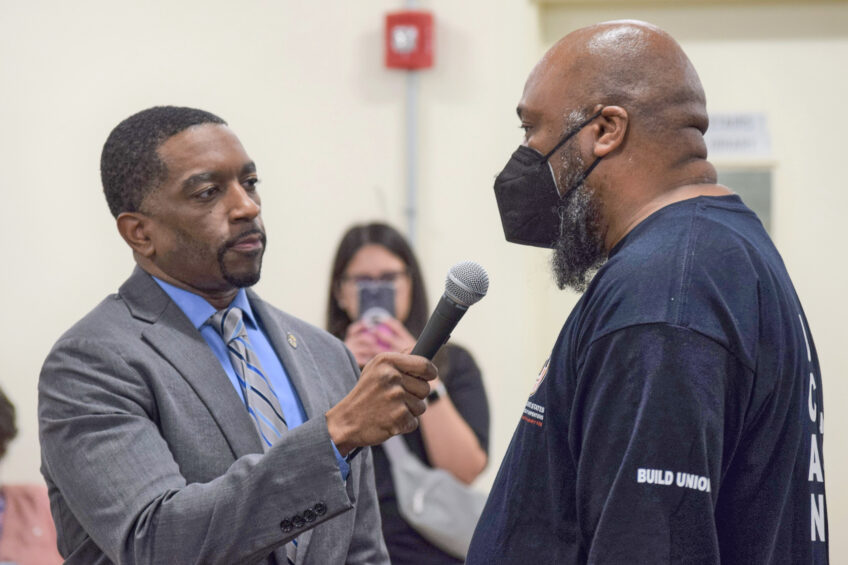Over 140 people gathered in the Greenbelt Library meeting room on February 15 to learn about the BluePrint Schools program (also known as P3) which has started to rebuild Prince George’s County Public School (PGCPS) buildings. Mayor Emmett Jordan spoke first to the packed meeting room about how Greenbelt loves books, with the Greenbelt Library having the highest circulation of all of Prince George’s County libraries. Councilmembers Ric Gordon, Kristen Weaver and Judith Davis also attended the meeting. Jonathan Briggs, Prince George’s County School Board Member for District 2, representing Greenbelt, was also present, as were many representatives from various unions. Jason Washington, director of infrastructure for PGCPS, was the main speaker. Mel Franklin, at-large Prince George’s County Councilmember, moderated the meeting and answered some questions.
BluePrint Schools
The BluePrint Schools program to replace aging and crowded school buildings is a 30-year program to reconfigure some assets of the school system but, according to Washington, not a panacea to correct all problems nor a model they’d want to pursue for building all future schools. However, it is a public-private partnership that will enable the system to build more schools faster than they could otherwise at a time when overcrowding and aging buildings make it necessary. Prince George’s County Education and Community Partners (PGCECP) works to develop the BluePrint Schools program. PGCECP organizations include Fengate Capital Management and Gilbane Development, two of North America’s leading alternative project delivery firms. Gilbane Building Company and Stantec will serve as the Design-Build team, and Honeywell International will be the Facilities Services firm.
Financing Schools
Prior to BluePrint Schools, to get financing, the county would float a bond which is based on tax revenues. Prior processes resulted in slow project completion with a seven-year average time from procurement to delivery of a public school. Maintenance was not stipulated in the contracts so maintenance cost is borne by the school system each budget year causing “deferred maintenance costs” in the school budget which may preclude building new schools.
The BluePrint Schools Public-Private Partnership is the first of its kind in the nation. Private businesses borrow money to design, build and maintain schools and the school system/county/state will pay managed payments over the 30-year period. The process is faster because procurements are bundled together. Phase I, already underway, is to design, build, finance and maintain six schools. The process guarantees a 30-year maintenance program for the school. The maintenance will be handled by the Phase III maintenance contract (Honeywell is the facility services provider), saving the school system deferred maintenance costs which can be used to enhance educational programs.
Phase I Schools
Projections of student population for the schools to be built have been set at 850 students per elementary school, 1,200 students for middle school, 2,000 students per K-8 schools and academies and 2,500 students per high school. Here is the Phase I schools list: to be completed by July 15, 2023 – Kenmoor Middle School, Drew-Freeman Middle School, Hyattsville Middle School and Sonia Sotomayor Middle School in Adelphi; to be completed by August 4, 2023 – Walker Mill Middle School; to be completed by November 8, 2023 – Colin L. Powell Academy.
Phase II Schools
Tentatively, Phase II schools are Robert Frost K-8 school (includes Robert Frost Elementary, Charles Carroll Middle School and Carrollton Elementary School), Margaret Brent Elementary (includes Margaret Brent Regional School and Glenridge Elementary School), Hyattsville Elementary, Springhill Lake Elementary, Brandywine K-8 (includes Gwynn Park Middle School and Brandywine Elementary School) and James Duckworth Regional School (includes James E. Duckworth Regional School, Calverton Elementary School and Beltsville Academy, which will not be closed but will have new boundaries). Phase II financing will close by July 1, 2024. All schools will be delivered in a three-year time frame from start to finish.
Attendee questions:
1) A resident of Greenbelt from Local 491 noted that the Phase II schools contract included Minority Business Enterprise (MBE) requirements but not a labor component to assure quality jobs and benefits. Washington responded that there is nothing in the Request for Proposals to preclude a team from submitting a labor component and proposals are selected on who can do the best job for the best value. From the presentation, all jobs on the project will be paid according to the State of Maryland Prevailing Wage Scale.
2) Where does the money come from for these projects? Washington discussed Phase II funding, although not final, as $25 million from the state, $15 million from PGCPS and $10 million from Prince George’s County. Franklin noted that all decisions must be approved by the state.
3) Are there apprenticeship programs? Washington mentioned that Gilbane is working with the schools to identify students that can come onto the jobs.
4) Do you keep track of and publish the work hours done by county residents? Washington noted that they have tracked MBE and County-based business participation in Phase I. He will work to set up that residency audit in Phase II.
5) When will the schools add metal detectors for security in county schools? Mel Franklin did an on-the-spot quick survey of the audience and noted that more people wanted metal detectors than didn’t, but many policy issues need clarification. Washington said that security policy has not been addressed by the committees yet.
More questions from the audience were unanswered because the library was closing and time had run out for the meeting.
Information on the BluePrint Schools program can be found on pgcpsblueprintschools.com.


